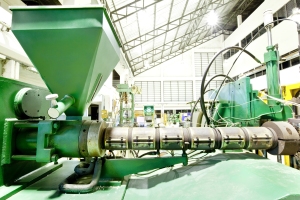Composite materials are materials made from two or more constituent materials with significantly different physical or chemical properties, that when combined, produce a material with characteristics different from the individual components.
The individual components remain separate and distinct within the finished structure. The new material may be preferred for many reasons: common examples include materials which are stronger, lighter or less expensive when compared to traditional materials. One of the most common composite materials in the plastics world are reinforced plastics, which are standard plastics combined with carbon or glass fiber to produce a stronger material.
Composite building materials such as cements, concrete
Reinforced plastics such as fiber-reinforced polymer
Metal Composites
Ceramic Composites (composite ceramic and metal matrices)
Composite materials have an enormous range of applications, including anything from the construction of buildings, bridges and structures, as well as in parts such as boat hulls, swimming pool panels, race car bodies, shower stalls, bathtubs, storage tanks, imitation granite and cultured marble sinks and counter tops. Composite materials can be found in practically any industry.
Thermoplastic composites are plastic specific composite materials, able to be produced on standard processing equipment such as extrusion or injection molding, however, additional materials or additives are combined with the plastic to change the physical properties to achieve a desired specification. Some of the advantages of thermoplastic composites include unlimited shelf life, faster production, and the recyclability of scrap. Thermoplastic composites offer substantial reductions in flammability, and smoke and toxicity performance, and are relatively insensitive to chemical attack. Typical uses are in automotive, sporting goods, marine use, and in construction. Some thermoplastic composites for example are designed to withstand extreme temperature environments, for example in many aircraft or in industrial applications. Other composites may focus on strength or wear resistance.
It is important to note the difference between thermoplastics and thermoset materials. A thermoset is a petrochemical material that irreversibly cures following a catalytic reaction. The cure may be induced by heat, generally above 200 °C (392 °F), through a chemical reaction, or by suitable irradiation.Thermoset materials are usually liquid or malleable prior to curing and are designed to be molded into their final form, or used as adhesives. Others are solids like that of the molding compound used in semiconductors and integrated circuits (IC).
 In contrast to crosslinking thermosets, whose cure reaction cannot be reversed, thermoplastic composites harden when cooled but retain their plasticity; that is, they will melt once again and can be reshaped by reheating them above their processing temperature. Less-expensive thermoplastic composites offer lower processing temperatures but also have limited use temperatures.
In contrast to crosslinking thermosets, whose cure reaction cannot be reversed, thermoplastic composites harden when cooled but retain their plasticity; that is, they will melt once again and can be reshaped by reheating them above their processing temperature. Less-expensive thermoplastic composites offer lower processing temperatures but also have limited use temperatures.
Since the 1960s, the vast majority of composite materials for aerospace have been based on thermoset materials, especially in the United States, due to their material cost and the costs associated with conversion to new materials, such as thermoplastics. However, limitations of thermoset polymers, such as their inability to be re-melted, shorter shelf-life, higher storage costs, and longer curing times, coupled with pressures to reduce weight and an otherwise evolving aerospace environment, have opened up opportunities for thermoplastic composites.
Thermoplastic composite materials have changed the landscape of materials and are continuously being introduced into new industries, products, and applications. The following are the advantages of thermoplastic #composite materials:
Affordable replacement of aluminum, steel and titanium
Increased toughness
Enhanced stiffness
Longer material lifespan
Non-toxic to produce
Recyclable for other processes
Low manufacturing cost
Weldable
Reshaping and reforming flexibility
Recyclable for other processes
These are the basics of composites and thermoplastic composites.







0 comments:
Post a Comment